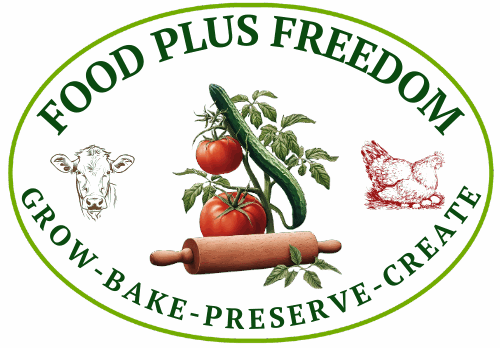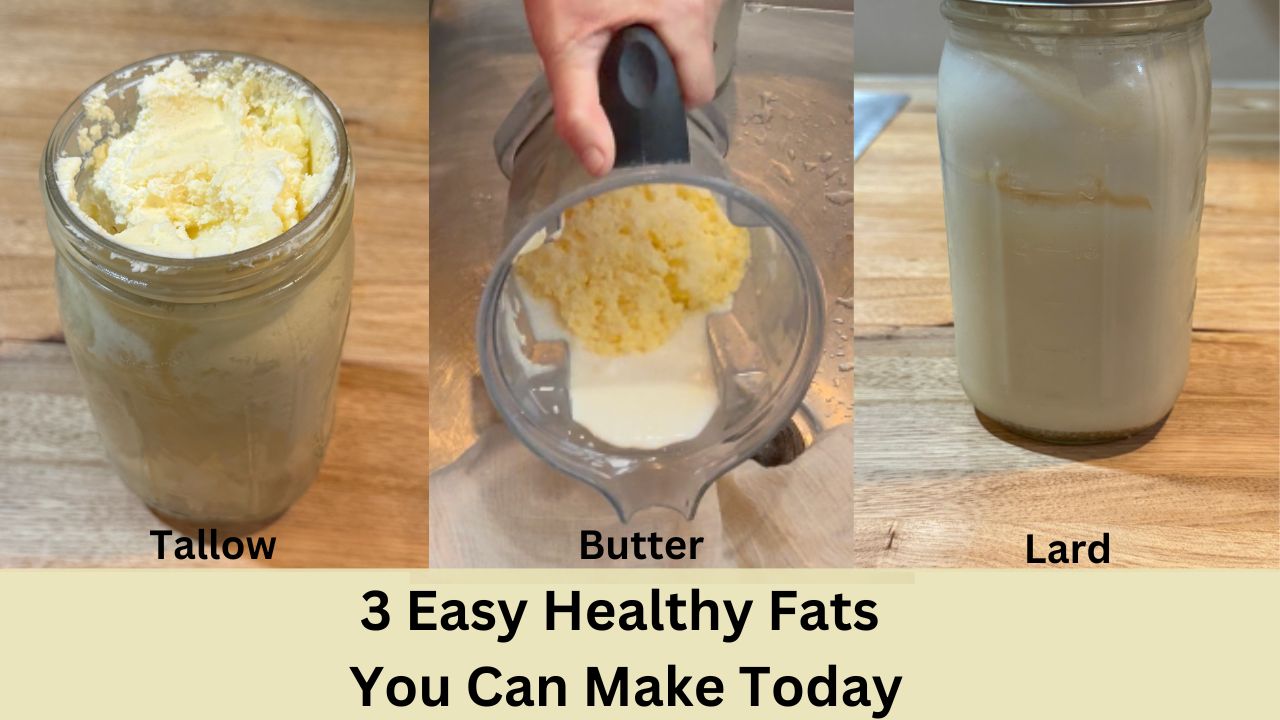With all the information floating around about fats, what are you to believe? What fats are good for you? What fats are bad to consume? Your body depends on healthy fats for regularity, brain power, heart health, and much more. Yet eating fat became taboo.
I’m not a doctor or a scientist. Though I use food as my medicine. I experiment with food and herbs to create a healthier me. You can too.
The food industry wants you to believe that many oils are genuine or beneficial to your health. I grew up with margarine, a chemical substance that is one molecule away from plastic. This doesn’t really sound healthy to me. Does it sound healthy to you?
Three Fats You Can Make At Home
With all the crap in your food, it’s nice to know you can create three healthy cooking fats at home. You can make butter from cream. Lard from rendered pig fat. Tallow from rendered beef fat.
You can use these fats for eating, cooking, baking, soap making, creams, and candles.
With pork and beef, you will render the fat. Rendering is the act of cooking down the hard fat into a liquid.
Sourcing Quality Fats
If you don’t have your own milk and beef cows or pigs, you may think you can’t make good fat for yourself. You’d be mistaken. There are many places to find good, quality, reliable sources to make your fat.
Go with the best quality raw material to make your fat. Find raw cream or milk from a grass-fed, organically grown cow that grazes in the pasture. Find fat from humanely raised organically grown pigs.
Talk to butchers in your area. Though they will not know how the animals were raised. Talk to homesteaders and small farms about buying fat from them. This way, you can ask how the animals are raised. Some will let you visit, so you can see for yourself.
What type of fat do you want?
For butter, you need raw cream. You can make butter with store bought pasteurized milk, but it’s not the same as making it from raw milk. Some people who sell raw milk will sell cream separately. Most likely you’ll need to buy raw milk, let the cream rise, scoop it off, and make it. The color of your cream will be from a light yellow white to a dark yellow. This coloring depends on the breed of cattle, butterfat, and what the animal is eating. Our cream is much more yellow when our cows are on a new pasture with cloves, then when they are eating only hay.
We keep fresh butter in the refrigerator for daily use. When we make extra, I freeze it for baking or for when we aren’t milking.
Pork:
There are three different types of pork fat. When you buy pork fat, or receive it from your own butchered animal, you may find that the fat is all lumped together. These are the types of pork fat from the pig. Plus, their best usage if they are rendered separately.
- Leaf Lard Or Visceral Fat. This is the soft fat around the kidneys. The texture and flavor of leaf lard is neutral. Some say it is the best fat for baking and making pastries.
- Pork Belly Fat: This is the fat from the belly area of the pig. The fat is thicker and richer with a slight pork flavor. Some say this is great fat for cooking and frying.
- Trimmed Pork Fat: This fat comes from the entire pig. It’s the fat that butchers trim off of different cuts of meat and the connective tissues. This fat is cleaner or whiter than other fat.
- Shoulder Fat: Is the fat from the shoulder area of the pig. This fat isn’t as neutral flavoring as leaf lard, but is an excellent fat for rendering.
Beef:
With beef you need to make sure you get the saturated fat, meaning the harder fat from the beef. The color of the fat can range from white to yellow, depending on the breed of cow, their age, and what they are eating. The jiggling fat you see after making bone broth and letting it cool will not work for rendering into tallow.
There are five different types of fat on a beef. You can render them all together without an issue. If your butcher divides the different types of fat, you can render them individually. Many times, you will not have the option of knowing where the fat is coming from.
- Trimmed Fat: This is all fat that has been trimmed from cuts of meat.
- Leaf Fat. Theses are leaf-like fatty deposits found on the underside of the cow’s belly, near the kidneys. This fat is considered to be the most mild type of beef fat.
- Hard white fats: These fats come from around the organs of the beef.
- Rump fat: Or the fat that is found around the rump of the beef.
- Rib Fat: This is the fat from around the ribcage area.
How to make each type of fat?
Butter
In order to make butter you separate the cream from the milk. Then you whip the fresh cream until it makes whipped cream, then continue until it becomes butter. Then you separate the buttermilk from the cream by pouring the mixture through a cloth. Save the butter milk for drinking and baking. Then wash the butter to get more buttermilk out, salt, and freeze. Or use right away.
Tallow and Lard
We make both tallow and lard in the same manner. First, you cut off any meat from the fat. You can cook this meat cut-offs and make a crackle. We’ve found by cooking crackle while making our fat, it makes the fat taste more like beef or pork. It’s also easier to burn your fat and get a burnt taste. Plus, the fat isn’t as clear and pure.
In a pan, Insta Pot, slow cooker, in the oven, or a roaster, add water, then the cut up pieces of fat, then simmer the fat down into a liquid. The cooking of the fat is called rendering.
No, you do not want to mix pork fat and beef fat to render together. They have different textures and tastes.
Once the fat is rendered down to mostly liquid, scoop out any extra pieces of fat that are not cooking down.
Strain the melted fat through a tightly woven cheese cloth into a metal bowel.
Put the metal bowel into the freezer.
Once frozen, pop the solid fat out and scrap off the impurities in the bottom.
Beware the fat will solidify quicker than the water, or any beef or pork liquid left on the fat. The fat rises to the top, while impurities, extra water, liquids, etc. sink to the bottom.
Put the solid fat back into the pot with water and melt it on warm. You don’t want to cook it, but melt it. Then pour it back into the bowl and freeze and repeat, scraping off the impurities.
Continue performing the above step until you achieve a clean fat without impurities.
Once the fat seems pure, melt it down one last time for storing. Though some people just store the fat in the freezer in this form, we do not.
We heat the oil down one last time, and pour them into canning jars and process. You can freeze or can your lard and tallow for later use.
We process the canning jars in a pressure canner for 50 minutes on 10 pounds of pressure due to our altitude. The tallow will be hard, while the lard will be softer.
Whipped tallow is softer, and more useable than rendered tallow that has cooled. We whip tallow from our canned tallow before use.
To make whipped tallow whip or blend the tallow in a blender or with a mixer as it’s cool and before it’s solidified.
Using Your Fat Daily.
You will need to experiment with what and how you want to cook with your new found fats you’ve made.
You most likely will not slather tallow or lard onto a piece of toast, but then again you might.
You can bake and cook with any of these fats. You may need to adjust your recipe. Remember, before margarine and Crisco came out (another super bad fat for you), people cooked and baked with animal fats.
You can also create flavored fats like garlic butter, garlic lard, garlic tallow by adding chopped up garlic to the fat. You can also take these flavored fats and pour them into ice cube trays. Once frozen, pop the fat cubes into a container and use as needed.
Making healthy fat is not only easy to do, but rewarding.
Congratulations, you’ve added one more level of food freedom to your life.
Enjoy!

